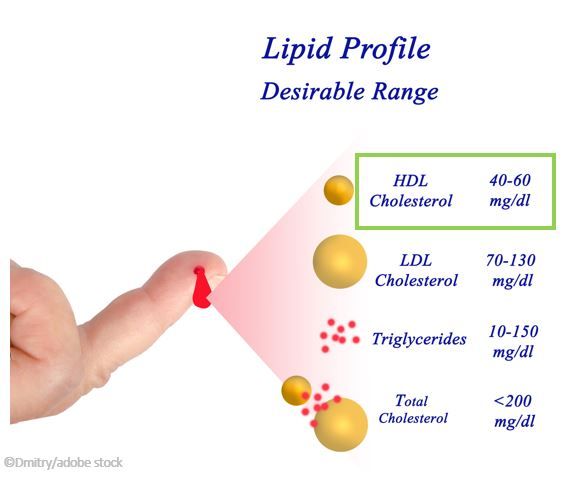HDL Cholesterol May Not Universally Predict Risk for CHD, May No Longer be So "Good"

Current cardiovascular risk assessment calculations that rely on values for high-density lipoprotein cholesterol (HDL-C) may lead to inaccurate assessment of risk in Black adults, according to an analysis of coronary heart disease (CHD) risk in a contemporary biracial cohort of more than 23 000 adults.
Investigators evaluated risk based on plasma lipid profiles and found that levels of low-density lipoprotein cholesterol (LDL-C) and triglycerides “modestly” predicted CHD risk in both Black and White adults. They also found that low levels of HDL-C were associated with increased CHD risk in White adults, but not Black adults and that elevated HDL-C was not protective in either group.
The findings appear to contradict the long-accepted association of HDL-C as the “good cholesterol” established by the Framingham Heart Study in the 1970s and suggest that the lipid may actually be limited in its use to uniformly predict CHD risk across racial and ethnic backgrounds.
“The goal was to understand this long-established link that labels HDL as the beneficial cholesterol, and if that’s true for all ethnicities,” said senior investigator Nathalie Pamir, PhD, associate professor of medicine within the Knight Cardiovascular Institute at Oregon Health & Science University, in a statement from the National Institutes of Health which supported the analysis. “It’s been well accepted that low HDL cholesterol levels are detrimental, regardless of race. Our research tested those assumptions.”
“The goal was to understand this long-established link that labels HDL as the beneficial cholesterol, and if that’s true for all ethnicities. It’s been well accepted that low HDL cholesterol levels are detrimental, regardless of race. Our research tested those assumptions.”
The inverse and linear association between plasma HDL-C concentration and CHD risk seen in the Framingham results was confirmed in other cohorts that also were predominantly of White European origin, the authors write. More recent data has found the association “weaker and even absent in racially diverse cohorts,” they add, leaving open the question of whether clinical risk categories for CHD that use HDL-C levels are appropriate for all.
To explore further, Pamir and colleagues assessed the impact of race on the association of lipid levels with incident CHD in the Reasons for Geographic and Racial Differences in Stroke (REGARDS) study.
The REGARDS cohort was enrolled between 2003 to 2007 and numbered 30 239 community dwelling Black and White adults aged ≥45 years. Of these, 23 901 had no history of CHD at baseline. Mean age of the final cohort was 64±9 years, 57.8% were White, and 58.4% were women. Underlying risk factors for heart disease, including diabetes, hypertension, and current smoking were similar among participants, the study notes.
FINDINGS
During a median of 10 years of follow-up, there were 664 CHD events among Black participants and 951 events among White participants. To estimate the race-specific hazard of plasma lipid levels with incident CHD investigators used Cox regression models which were adjusted for clinical and behavioral risk factors, according to the study.
Pamir et al report that LDL-C and triglycerides were associated with an increased risk of CHD in both Whites and Blacks (Pinteraction by race >.10).
After adjustment for clinical risk factors, analysis showed that low HDL-C was associated with increased risk of CHD in White (HR, 1.22 [95% CI, 1.05-1.43]) but not in Black (HR, 0.94 [95% CI, 0.78-1.14]) adults (Pinteraction by race =.08). The research team also found that high HDL-C was no longer protective, ie, not associated with decreased CHD events, in either White (HR, 0.96 [95% CI, 0.79-1.16] or Black (HR, 0.91 [95% CI, 0.74-1.12]) participants.
In sensitivity analyses to determine whether the observed differences were sustained when other predictors were allowed to vary between Black and White subgroups, the high HDL-C clinical category again translated to cardioprotection among White but not Black participants.
“What I hope this type of research establishes is the need to revisit the risk-predicting algorithm for cardiovascular disease,” said Pamir. “It could mean that in the future we don’t get a pat on the back by our doctors for having higher HDL cholesterol levels.”
“What I hope this type of research establishes is the need to revisit the risk-predicting algorithm for cardiovascular disease,” said Pamir. “It could mean that in the future we don’t get a pat on the back by our doctors for having higher HDL cholesterol levels.”
Findings from this analysis of REGARDS are the first to demonstrate lower HDL-C was predictive of CHD only for White adults. The analysis also builds on existing data that show high levels of HDL-C don’t always correlate with reduced cardiovascular events; it is now the largest US analysis to suggest that this extends to both Black and White adults and further that elevated levels of the heretofore good cholesterol may not actually be beneficial for either population.
“HDL cholesterol has long been an enigmatic risk factor for cardiovascular disease,” explained Sean Coady, a deputy branch chief of epidemiology within the NIH’s National Heart, Lung, and Blood Institute’s Division of Cardiovascular Sciences, in the NHLBI statement. “The findings suggest that a deeper dive into the epidemiology of lipid metabolism is warranted, especially in terms of how race may modify or mediate these relationships.”
Reference: Zakai NA, Minnier J, Safford MM, et al. Race-dependent association of high-density lipoprotein cholesterol levels with incident coronary artery disease. J Am Coll Cardiol. 2022;80:2104–2115. doi:epdf/10.1016/j.jacc.2022.09.027